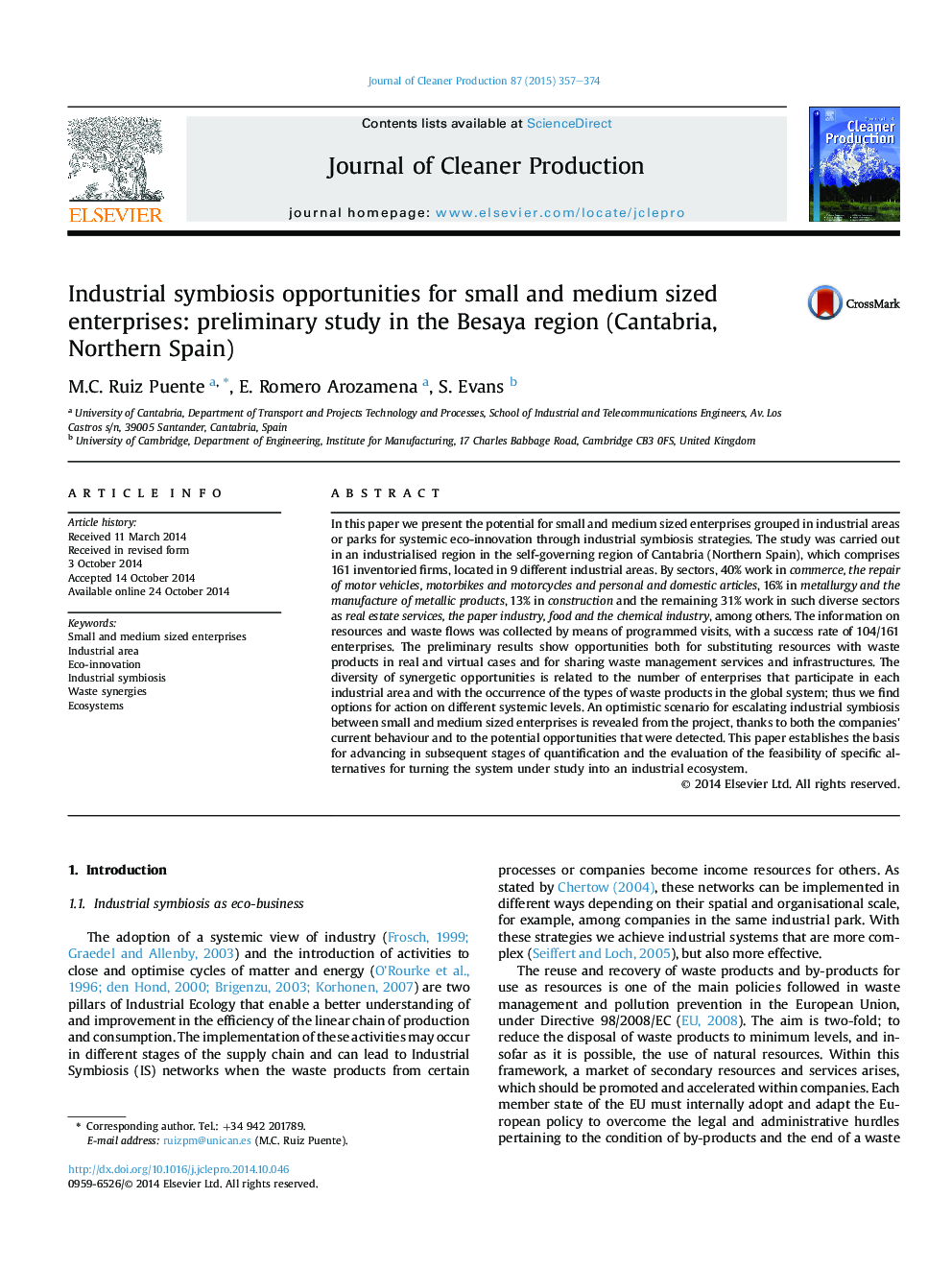| کد مقاله | کد نشریه | سال انتشار | مقاله انگلیسی | نسخه تمام متن |
|---|---|---|---|---|
| 8105184 | 1522159 | 2015 | 18 صفحه PDF | دانلود رایگان |
عنوان انگلیسی مقاله ISI
Industrial symbiosis opportunities for small and medium sized enterprises: preliminary study in the Besaya region (Cantabria, Northern Spain)
ترجمه فارسی عنوان
فرصت های همزیستی صنعتی برای شرکت های کوچک و متوسط: مطالعه اولیه در منطقه بسا (کانتبریا، شمال اسپانیا)
دانلود مقاله + سفارش ترجمه
دانلود مقاله ISI انگلیسی
رایگان برای ایرانیان
کلمات کلیدی
شرکت های کوچک و متوسط، منطقه صنعتی، محیط زیست نوآوری، همزیستی صنعتی، ترکیبات زباله، اکوسیستم،
ترجمه چکیده
در این مقاله پتانسیل برای شرکت های کوچک و متوسط گروه بندی شده در مناطق صنعتی یا پارک ها برای نوآوری های سازگار با محیط زیست را از طریق استراتژی های همزیستی صنعتی ارائه می کنیم. این مطالعه در یک منطقه صنعتی در منطقه خودمختار کانتبریا (شمال اسپانیا) انجام شد که از 161 شرکت ثبت شده در 9 منطقه صنعتی مختلف تشکیل شده است. در بخش ها، 40٪ در تجارت، تعمیر وسایل نقلیه موتوری، موتورسیکلت و موتور سیکلت و محصولات شخصی و خانگی، 16٪ در متالورژی و تولید محصولات فلزی، 13٪ در ساخت و ساز و 31٪ باقی مانده در چنین بخش های گوناگون کار می کنند. خدمات املاک و مستغلات، صنعت کاغذ، مواد غذایی و صنایع شیمیایی، و غیره. اطلاعات مربوط به منابع و جریانهای پساب با استفاده از برنامه های بازدید شده، با میزان موفقیت 161/161 شرکت جمع آوری شد. نتایج اولیه نشان می دهد که فرصت ها برای جایگزینی منابع با مواد زائد در موارد واقعی و مجازی و برای به اشتراک گذاری خدمات و زیرساخت های مدیریت زباله نشان می دهد. تنوع فرصت های هم افزایی مربوط به تعداد شرکت هایی است که در هر منطقه صنعتی مشارکت می کنند و با انواع مواد زائد در سیستم جهانی درگیر هستند. بنابراین گزینه هایی برای عمل در سطوح مختلف سیستمیک پیدا می کنیم. سناریوی خوش بینانه برای افزایش همزیستی صنعتی بین شرکت های کوچک و متوسط از این پروژه به علت رفتار فعلی شرکت ها و فرصت های بالقوه شناسایی شده است. این مقاله مبنایی برای پیشبرد در مراحل بعدی تعیین مقدار و ارزیابی امکان جایگزینی خاص برای تبدیل سیستم مورد مطالعه به یک اکوسیستم صنعتی است.
موضوعات مرتبط
مهندسی و علوم پایه
مهندسی انرژی
انرژی های تجدید پذیر، توسعه پایدار و محیط زیست
چکیده انگلیسی
In this paper we present the potential for small and medium sized enterprises grouped in industrial areas or parks for systemic eco-innovation through industrial symbiosis strategies. The study was carried out in an industrialised region in the self-governing region of Cantabria (Northern Spain), which comprises 161 inventoried firms, located in 9 different industrial areas. By sectors, 40% work in commerce, the repair of motor vehicles, motorbikes and motorcycles and personal and domestic articles, 16% in metallurgy and the manufacture of metallic products, 13% in construction and the remaining 31% work in such diverse sectors as real estate services, the paper industry, food and the chemical industry, among others. The information on resources and waste flows was collected by means of programmed visits, with a success rate of 104/161 enterprises. The preliminary results show opportunities both for substituting resources with waste products in real and virtual cases and for sharing waste management services and infrastructures. The diversity of synergetic opportunities is related to the number of enterprises that participate in each industrial area and with the occurrence of the types of waste products in the global system; thus we find options for action on different systemic levels. An optimistic scenario for escalating industrial symbiosis between small and medium sized enterprises is revealed from the project, thanks to both the companies' current behaviour and to the potential opportunities that were detected. This paper establishes the basis for advancing in subsequent stages of quantification and the evaluation of the feasibility of specific alternatives for turning the system under study into an industrial ecosystem.
ناشر
Database: Elsevier - ScienceDirect (ساینس دایرکت)
Journal: Journal of Cleaner Production - Volume 87, 15 January 2015, Pages 357-374
Journal: Journal of Cleaner Production - Volume 87, 15 January 2015, Pages 357-374
نویسندگان
M.C. Ruiz Puente, E. Romero Arozamena, S. Evans,
